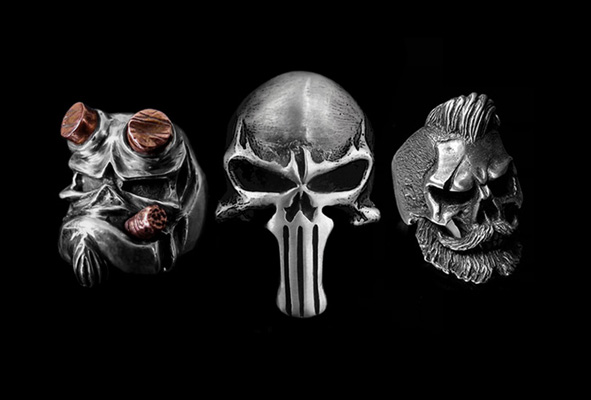In the realm of jewelry, there exists a piece that transcends mere fashion and enters the domain of symbolism and mystique—the skull ring. Often adorned with intricate details and crafted with meticulous precision, the skull ring has emerged as a potent symbol, carrying layers of meaning that intrigue and captivate wearers and admirers alike.
From ancient civilizations to contemporary subcultures, the skull has maintained a significant presence, symbolizing mortality, rebellion, and even wisdom. Its depiction in jewelry, particularly in the form of rings, has a rich history intertwined with cultural, spiritual, and personal significance.
A Symbol of Mortality and Transience:
At its core, the skull serves as a reminder of the transient nature of life—a motif that has pervaded human consciousness across cultures and epochs. In ancient Mesoamerican civilizations like the Aztecs and the Maya, the skull was revered as a symbol of death and rebirth, often incorporated into rituals and religious ceremonies. Skull rings, adorned by warriors and spiritual leaders, were believed to offer protection in the afterlife and serve as a conduit between the mortal and spiritual realms.
An Emblem of Rebellion and Individuality:
Throughout history, the skull has also been embraced as a symbol of defiance and rebellion, challenging societal norms and conventions. During the 18th century, the rise of the pirate culture saw the skull and crossbones emblem adorn flags and jewelry, signifying a life lived on the fringes of society, beyond the confines of authority and conformity. In more recent times, the skull ring has been adopted by countercultural movements, from punk rockers to bikers, as a badge of nonconformity and individuality—a tangible declaration of autonomy and resistance.
A Reflection of Wisdom and Enlightenment:
Paradoxically, the skull also embodies themes of wisdom and enlightenment, particularly in Eastern philosophies such as Buddhism and Hinduism. In Tibetan Buddhism, the skull symbolizes the impermanence of life and the transcendence of worldly attachments—an essential concept in the pursuit of spiritual awakening. Tantric practitioners often use skull cups, known as kapalas, in rituals symbolizing the transformation of negative energies into wisdom and compassion. The skull ring, in this context, becomes a talisman of inner transformation and enlightenment, a reminder to seek wisdom beyond the material realm.
A Personal Journey:
Beyond its cultural and symbolic significance, the allure of the skull ring lies in its deeply personal resonance with individuals. For some, it serves as a memento mori—a tangible reminder to seize the present moment and live authentically. For others, it represents a connection to a subculture or community, a visual identifier of shared values and experiences. And for many, it is simply a striking piece of wearable art—an expression of personal style and aesthetic sensibility.
Craftsmanship and Creativity:
In the hands of skilled artisans, the skull ring becomes a canvas for creativity and craftsmanship, with each piece bearing the unique imprint of its creator. From intricately carved designs to embellishments with precious stones and metals, skull rings come in a myriad of styles, catering to diverse tastes and preferences. Whether crafted in traditional metals like silver and gold or unconventional materials like titanium and carbon fiber, each ring carries with it the legacy of centuries-old techniques and contemporary innovation.





